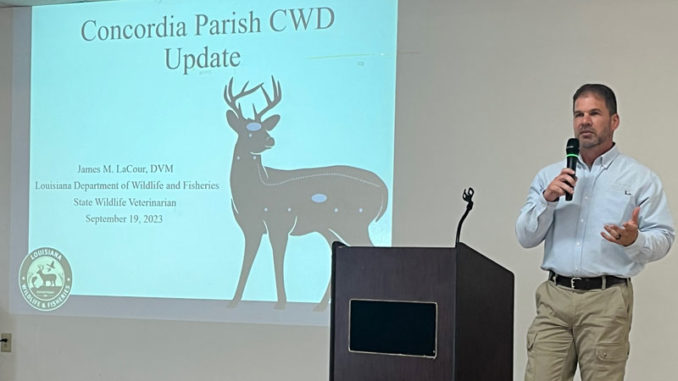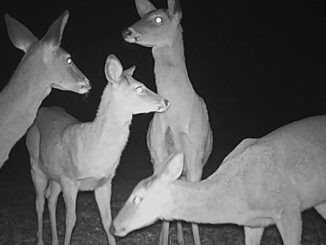
Chronic Wasting Disease (CWD) is here to stay and officials from the Louisiana Department of Wildlife and Fisheries (LDWF) were on hand Sept. 19 in Concordia Parish to remind hunters of that fact.
The northern portion of Concordia Parish was added earlier this year to the state CWD Control Area, which includes all of Tensas Parish and portions of Madison and Franklin parishes. The area expanded to La. Hwy 425, intersect La. Hwy 84 and to Natchez.
Slow moving disease
In the meeting held at the Concordia Community Center, officials asked for hunters and landowners to aid them in their fight to help control the spread of the deadly deer disease, which is 100 percent fatal in deer.
“It is a very slow onset disease which makes a perfect storm to spread the disease,” said Dr. James LaCour, LDWF state wildlife veterinarian.
Usually it takes 16 to 24 months of exposure for deer to start showing clinical signs even though CWD can spread nearly the entire time, LaCour said.
CWD is caused by prions, which are proteins normally found in the body that have mutated, according to LDWF. These prions accumulate in the brain and cause holes to develop in brain tissue. While prions are concentrated in the central nervous system, they can be found within other tissues of the infected animal, including muscle.
During that time, infected deer are spreading the disease through contact with other deer or through contact with urine, feces, saliva and body parts of infected deer or infectious materials in soil. Prions will bind to soil particles once an infected deer carcass has decomposed. According to LDWF, once in a location, the disease is present indefinitely.
There is no evidence CWD, which makes deer resemble “the walking dead,” can spread to humans.
Drop-off locations
Johnathan Bordelon, LDWF deer management personnel, said the control area was not static but could grow if more samples were found. Also, there is no sunset on the area, meaning it could be in place for as long as CWD is in existence.
CWD sampling drop-off locations are stationed throughout the area with two new locations in Concordia Parish. The first location is at the Louisiana Department of Transportation and Development office in Ferriday and Richard K. Yancey WMA on La. Hwy 15 south of Vidalia.
To provide a sample, hunters must first remove the antlers if present, and cut the deer’s neck four to six inches below the jaw. They are asked to fill out all the information on the card provided at the sampling location.
CWD Control Area rules:
- Baiting, placement of bait, or hunting over bait is prohibited within a LDWF designated CWD Control Area.
- The export of any cervid carcass or part of a cervid carcass originating within an LDWF designated CWD Control Area is prohibited, except for meat that is cut and wrapped; meat that has been boned out; quarters or other portions of meat with no part of the spinal column or head attached, antlers, clean skull plates with antlers, cleaned skulls without tissue attached, capes, tanned hides, finished taxidermy mounts and cleaned cervid teeth.
- Approved parts transported out of the CWD Control Area must be legally possessed. Approved parts must contain a possession tag with the hunter’s name, address, LDWF license number, parish of harvest, date of harvest, and sex of deer.
- LDWF has been directed to determine whether there is sufficient capacity to perform taxidermy services for cervids taken within the Control Area and report those findings to the Wildlife and Fisheries Commission. If it is determined that there is insufficient capacity to provide adequate taxidermy services for cervids harvested within the Control Area, LDWF shall establish a permitting system to be in effect to allow for uncleaned cervid heads to be transported out of the Control Area solely for taxidermy purposes.
CWD was first identified in captive deer in a Colorado research facility in the late 1960s, and in wild deer in 1981. By the 1990s, it had been reported in surrounding areas in northern Colorado and southern Wyoming. Nationally, the disease has been identified in deer in more than 30 states and four Canadian provinces in free-range and domesticated populations.

